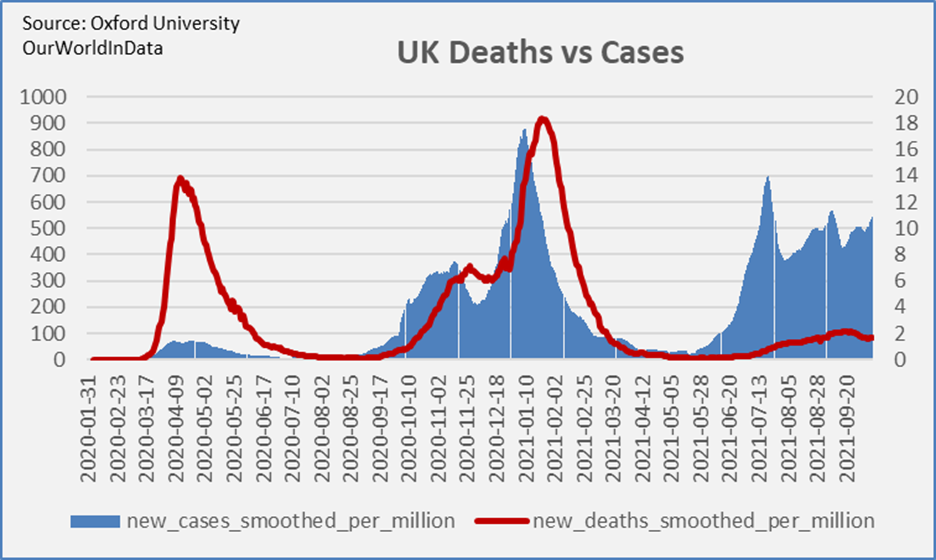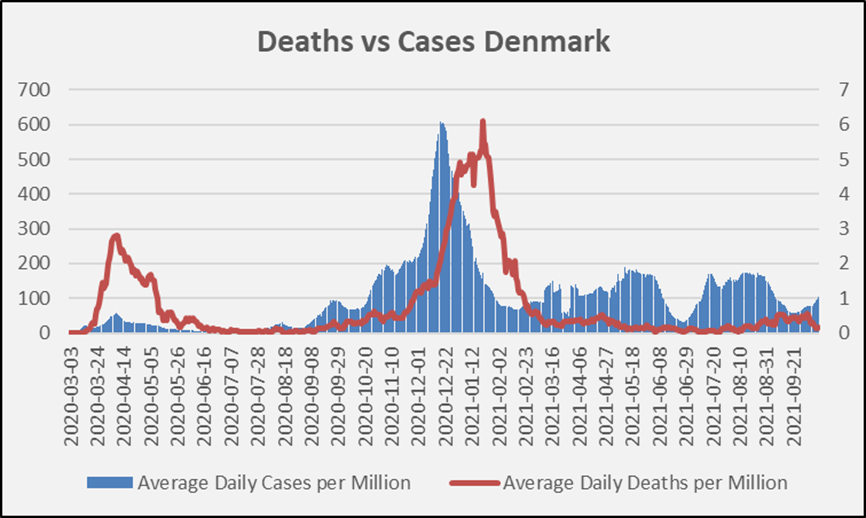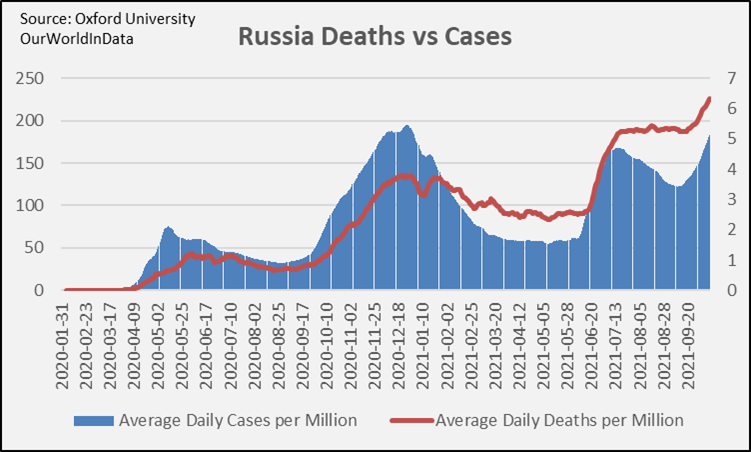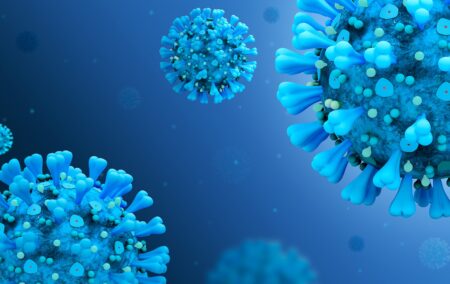What does the end of the pandemic look like?
One answer is provided by the UK, whose smoothed average Covid-19 deaths, and cases, are laid out in the following graph. Note that these are death and case numbers per million people in the population.

The pandemic does not end with a bang, but with a muffled cough. That is the short answer. The longer description of the graph above requires attending to the three distinct waves it shows. In the first wave, matching peaks, the ratio of deaths to cases maxed out at 1:5. In the second wave, that came down to almost 1:50. In the third, it came down to 1:325.
To be clear, these numbers do not give you the infection fatality ratio. Covid-19 is orders of magnitude less lethal than the “case fatality” approximations suggest, but the graph is a good indication of the change in lethality over time. Also, while there are confounding factors, like the fact that testing in the first wave was not as effective and old-age home iatrogenic deaths were more common, the overwhelming difference between the second and third waves is new immune protection.
Case numbers and deaths
Case numbers and death numbers diverge, ceteris paribus, when the human population has significant new immune protection that partially reduces the odds of catching the virus but reduces the odds of succumbing to the virus much more. That difference between how infectious the virus is and how deadly it is for the newly protected explains the vast difference in lethality at the level of national statistics.
But to get that difference in lethality at a social level requires the new protection to manifest at a societal level too. In the UK’s case most of this new immune protection has come from vaccination. Two thirds of the population are “fully” vaccinated and almost three quarters have received at least one jab.
In can be quite difficult to put into words what supermajority levels of immune protection, which can also be acquired through infection-and-recovery at great cost, means for society. The Danish government found a good way to describe the difference, and South Africans should take heed.
The case of Denmark
The Danes were the first Europeans to end all domestic Covid-19 restrictions when they allowed people to go nightclubbing without first having to present a vaccine-pass in early September. Explaining why they abandoned the impulse to compel or “nudge” everyone into vaccination the Danish government said the virus had been a “critical threat to society” but had become “an ordinary dangerous illness”.

That is exactly what life after the pandemic looks like: life as it is, with just another ordinary dangerous illness floating around. Nobody should need to tell you what that means, because you have lived your life in that position all along. If by nothing else than making it to the point of reading this sentence you demonstrably know how to survive in that environment.
Is vaccination the only way to get there? South Africa is an entirely different position to the UK, the Netherlands, Denmark, Switzerland, and Germany vaccination-wise. Those countries all have ended domestic curfews, but their vaccination rates are also all at least double, sometimes triple, our own.
That might incline you to think that we are on path more like Russia than Denmark and the UK. Unlike the latter, Russia is going through a grim autumn.
What’s going on in Russia?

The main lesson to draw from Russia’s current woe is that when only a significant minority of the population has achieved immune protection those individuals are better off but not enough for the national statistics to shift. Those who have neither recovered, nor been vaccinated, provide vast numbers of easy prey.
This turns out to be an indispensable lesson for South Africa too. A little over 20% are fully vaccinated here, so many “experts” will expect a fourth wave like Russian’s third wave. They will look back at those who spoke about South African “herd immunity” in the spring of 2020 and again in the autumn of 2021, as fools that have been proved wrong twice. They will “explain” that vaccination is the only protection there is, and that absent supermajority vaccination we are doomed to another “critical threat to society” this summer from both the virus and the Command Council’s incompetence.
But the point made by scientists at the time was that when only a minority of the population had convalescent protection then that minority was in a good position, but the society at large remained quite vulnerable. Russia vindicates the point yet again.
Immune protection is very good at saving the same body that immune system is in, and not nearly as good as protecting neighbours. The switch does not flick in a body until its own immune system gains new immune protection. But once a supermajority in a population has new immune protection the switch is flicked at the level of national statistics and Covid-19 undeniably becomes an ordinary illness from the perspective of national risk-management.
How protected are South Africans?
Take this lesson to mind and previous infection rates make sense. On Discovery’s estimates about a quarter of South Africans had convalescent protection by Spring last year, which climbed to half after the second wave, which was not enough to stop a third wave. Now Discovery estimates four fifths have recovery protection, which flicks us from Russia to the UK in terms of overall protection.
I happen to dispute the way Discovery generates these estimates. Their infection fatality ratio is too high but so are their estimated deaths. That dispute means my own estimates come in slightly lower, closer to two thirds. Either way, we are in UK-Danish territory in terms of newly acquired immune protection and that changes everything.
That means South Africans, currently experiencing extremely low death and case numbers, need to consider what life looks like when Covid-19 becomes just another bug on the hoof. It looks like the UK and Danish graphs above. That means our illness profile looks a lot like 2019.
Would you have sat comfy in 2019 while your government imposed a midnight curfew to stop the flu, or the common cold? Would you have leant back while the government maintained a “state of disaster” that would allow it to ban alcohol to stop the spread of HIV? Would you think it was ok to limit the size of funerals because TB kills hundreds of thousands every year, far more than Covid-19 has in almost 18 months?
If yes, I probably have little to add. But if not, join the IRR’s campaign to disband the Command Council now. The Command Council, and the State of Disaster that empower it, is set up to rule our lives even when our curve looks like the UK’s. You cannot be sure that our fourth wave will be a Danish trickle rather than a Russian torrent, in part because random sero-testing has been badly botched, but you can be sure that the Command Council will treat even an ordinary illness like an excuse to crush liberties and prosperity for exactly as long as the population resigns to that with a shrug.
If you have any doubt about the dictatorial aspirations of our current “leaders”, remember that we are voting this year because people channeled their energy into organizations like the IRR, which had to fight against Command Council leaders who were aiming to deny the basic right to vote.
You can join the campaign against the Command Council here.
If you like what you have just read, support the Daily Friend

